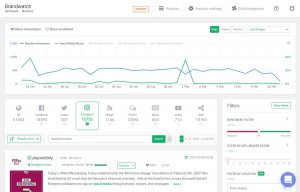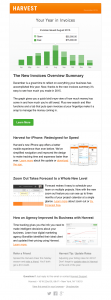
Have you tried segmenting your email marketing campaigns yet? It’s an effective way to convert leads into paying customers. This wave of personalization is sweeping the online marketing field—because it works.
This increase in personalization is also why you are receiving more and more marketing emails with your name in the subject line. Because personalization in the subject line leads to an 82 percent increase in the open rate and a 75 percent increase in the click-through rate.
Email list segmentation and personalized email marketing were the most effective email strategies of 2017. And with good reason: They are perfectly tailored to the recipient.
But consider this: Why not let your leads define themselves and tell you what kind of personalization they prefer? Wouldn’t that help you create even more targeted marketing campaigns with even more specific information?
Interested? Let’s dive in.
Why Segmenting Leads Is Important
It’s impossible to advertise or market to each lead you acquire individually, personally appealing to each person’s unique interests and wants. There just isn’t the time, and it isn’t remotely cost-effective.
But you can narrow the field a little by segmenting your leads into different groups. This process is known as bucketing.
So why bucket your leads? By dividing your leads into these smaller groups based on interests, needs or desires—or even by something as specific as location—you can appeal more directly to them and have a better chance of getting them to open an email, buy your product or visit your site.
The more you understand who your audience members are, the easier it is to create email marketing that inspires them to buy, click or connect.
Segmenting also might let you discover how different groups interact with your brand. Perhaps there is a large group of leads who are loyal to your brand, but you’ve not created a specific product particularly for them. Bucketing and segmenting, in tandem with data from your marketing campaigns, have the power to expose different segments of your leads who don’t have a true product of their own so you can reach this group.
And it really works: Recipients are 75 percent more likely to click on emails from segmented campaigns than from non-segmented emails.
Let’s say you run a boxing gym, and you have three kinds of clients: students who are taking classes to learn how to box, students who take solely fitness-based classes at your gym and those who pay to be there during open gym times for sparring.
You would offer different promotions to each of these kinds of students, right? Save time and marketing funds by sending information about class packs, discounted gym time and extra fitness classes only to interested parties, not to your whole list of leads.
The bonus to this? When your emails are created specifically to influence a particular group, your leads are more likely to open the email, and you’re more likely to convert a lead.
Boosting Bucketing: The Power of Self-Selection
So by allowing your leads to place themselves in these segments themselves, you are able to engage with them much more effectively and provide them with much more quality content. As a result, your leads are far less likely to unsubscribe, which happens when content is irrelevant to them.
Did you know that 60 percent of email marketers don’t allow their subscribers to select the kinds of emails they want to receive? And only 30 percent of email marketers allow their subscribers to select how often they want to get emails? Just this level of subscriber empowerment helps you engage as much as your leads want you to engage.
But this is just the beginning of self-selecting segmentation.
First of all, customers have to input the data for self-segmenting themselves, which means that it’s usually accurate. Each of these segments, based on age, city, industry or other preferences, has a set of rules, which are created by you. These rules help you create categories or various kinds of segments, so you can tailor your marketing campaigns to each one.
Self-selection means your leads share exactly as much information as they want. They can share as much or as little as they want, not pushing them outside their comfort zone. And you still get relevant information that you can use to provide targeted, effective emails.
Self-selection and self-segmenting can be as beneficial for your leads as it is for you. It can be an incentive.
For example, if you run a skincare company, you can have your leads provide you with information about their skin type, age, location and other preferences, and you can match them with the right moisturizer—and follow it up with a promotional email for a discount. This means you also have information about your lead to place them in a particular bucket and send them emails regarding similar products they might love just as much.
It’s mutually beneficial.
Creating Buckets or Options for Self-Selection
There are countless ways to segment your leads in order to effectively market to them. Based on how your leads interact with your company and your website and how your brand operates, you may find that some groups or buckets are more successful than others in reaching groups of your leads and convincing them to click or buy.
Unsure of where to start? Let’s take a look at a few different kinds of segments you might create and questions you might ask:
- Geographical location (and if they live in the city, the suburbs or rural areas)
- Buying behavior, or how frequently they interact with your brand
- Retail store vs. website traffic
- Beliefs, mindsets and preferences
- Age and/or gender
- Job title or occupational industry
- Lifestyle, social standing, activities
- Demographics like family size, income, religion, race or nationality
So how can this information be used?
If a lead provides their geographical location, you have more information about what kinds of goods or services to suggest for them.
Are you an online clothing retailer? You can send out promotions about sales on winter coats to customers who live in the midwest. And you don’t have to send this email to leads who live in southern California and bombard them with unnecessary emails they don’t need or want.
Ultimately, self-segmenting is the 21st-century version of you getting to know a customer who previously may have walked into your storefront. Gone are the days of knowing each customer in your local business by name and preference. And gone are the days of walking each customer to the specific product that matches their needs and interests.
But with bucketing and self-segmentation? It gets a little easier.
Business & Finance Articles on Business 2 Community
(27)






